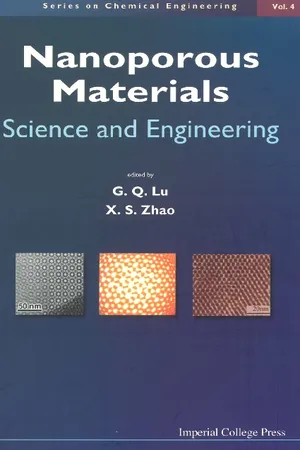
- 912 pages
- English
- PDF
- Available on iOS & Android
Nanoporous Materials: Science And Engineering
About this book
Porous materials are of scientific and technological importance because of the presence of voids of controllable dimensions at the atomic, molecular, and nanometer scales, enabling them to discriminate and interact with molecules and clusters. Interestingly the big deal about this class of materials is about the "nothingness" within — the pore space. International Union of Pure and Applied Chemistry (IUPAC) classifies porous materials into three categories — micropores of less than 2 nm in diameter, mesopores between 2 and 50 nm, and macropores of greater than 50 nm. In this book, nanoporous materials are defined as those porous materials with pore diameters less than 100 nm.Over the last decade, there has been an ever increasing interest and research effort in the synthesis, characterization, functionalization, molecular modeling and design of nanoporous materials. The main challenges in research include the fundamental understanding of structure-property relations and tailor-design of nanostructures for specific properties and applications. Research efforts in this field have been driven by the rapid growing emerging applications such as biosensor, drug delivery, gas separation, energy storage and fuel cell technology, nanocatalysis and photonics. These applications offer exciting new opportunities for scientists to develop new strategies and techniques for the synthesis and applications of these materials.This book provides a series of systematic reviews of the recent developments in nanoporous materials. It covers the following topics: (1) synthesis, processing, characterization and property evaluation; (2) functionalization by physical and/or chemical treatments; (3) experimental and computational studies on fundamental properties, such as catalytic effects, transport and adsorption, molecular sieving and biosorption; (4) applications, including photonic devices, catalysis, environmental pollution control, biological molecules separation and isolation, sensors, membranes, hydrogen and energy storage, etc.
Frequently asked questions
- Essential is ideal for learners and professionals who enjoy exploring a wide range of subjects. Access the Essential Library with 800,000+ trusted titles and best-sellers across business, personal growth, and the humanities. Includes unlimited reading time and Standard Read Aloud voice.
- Complete: Perfect for advanced learners and researchers needing full, unrestricted access. Unlock 1.4M+ books across hundreds of subjects, including academic and specialized titles. The Complete Plan also includes advanced features like Premium Read Aloud and Research Assistant.
Please note we cannot support devices running on iOS 13 and Android 7 or earlier. Learn more about using the app.
Information
Table of contents
- Preface
- Contents
- Chapter 1 NANOPOROUS MATERIALS – AN OVERVIEW
- Chapter 2 ADVANCES IN MESOPOROUS MATERIALS TEMPLATED BY NONIONIC BLOCK COPOLYMERS
- Chapter 3 ZEOLITE/MESOPOROUS MOLECULAR SIEVE COMPOSITE MATERIALS
- Chapter 4 CHROMIUM-CONTAINING ORDERED NANOPOROUS MATERIALS
- Chapter 5 SURFACTANT-TEMPLATED MESOSTRUCTURED MATERIALS: SYNTHESIS AND COMPOSITIONAL CONTROL
- Chapter 6 ORGANIC HOST–GUEST STRUCTURES IN THE SOLID STATE
- Chapter 7 NONSURFACTANT ROUTE TO NANOPOROUS PHENYL-MODIFIED HYBRID SILICA MATERIALS
- Chapter 8 3D MACROPOROUS PHOTONIC MATERIALS TEMPLATED BY SELF ASSEMBLED COLLOIDAL SPHERES
- Chapter 9 HYDROPHOBIC MICROPOROUS SILICA MEMBRANES FOR GAS SEPARATION AND MEMBRANE REACTORS
- Chapter 10 SYNTHESIS AND CHARACTERIZATION OF CARBON NANOTUBES FOR HYDROGEN STORAGE
- Chapter 11 PHYSICAL ADSORPTION CHARACTERIZATION OF ORDERED AND AMORPHOUS MESOPOROUS MATERIALS
- Chapter 12 MOLECULAR SIMULATION OF ADSORPTION IN POROUS MATERIALS
- Chapter 13 SURFACE FUNCTIONALIZATION OF ORDERED NANOPOROUS SILICATES
- Chapter 14 SURFACE ALUMINATION OF MESOPOROUS SILICATES
- Chapter 15 ACIDITY MEASUREMENT OF NANOPOROUS ALUMINOSILICATES – ZEOLITES AND MCM-41
- Chapter 16 NANOCATALYSTS PREPARED BY THE MOLECULARLY DESIGNED DISPERSION PROCESS
- Chapter 17 ACIDITY-ENHANCED NANOPOROUS CATALYTIC MATERIALS
- Chapter 18 MODIFIED MESOPOROUS MATERIALS AS ACID AND BASE CATALYSTS
- Chapter 19 LEWIS ACID/BASE CATALYSTS SUPPORTED ON NANOPOROUS SILICA AS ENVIRONMENTAL CATALYSTS
- Chapter 20 NANOPOROUS CATALYSTS FOR SHAPE-SELECTIVE SYNTHESIS OF SPECIALTY CHEMICALS: A REVIEW OF SYNTHESIS OF 4,4’-…
- Chapter 21 CATALYSIS INVOLVING MESOPOROUS MOLECULAR SIEVES
- Chapter 22 ADSORPTION AND TRANSPORT IN NANOPOROUS MATERIALS
- Chapter 23 ADSORPTION OF ORGANIC MOLECULES IN NANOPOROUS ADSORBENTS FROM AQUEOUS SOLUTION
- Chapter 24 FUNCTIONALIZED NANOPOROUS ADSORBENTS FOR ENVIRONMENTAL REMEDIATION
- Chapter 25 NANOPOROUS ADSORBENTS FOR AIR POLLUTANT REMOVAL
- Chapter 26 BIOADSORPTION AND SEPARATION WITH NANOPOROUS MATERIALS
- Chapter 27 NANOPOROUS MATERIALS AS SUPPORTS FOR ENZYME IMMOBILIZATION
- Chapter 28 A NOVEL NONSURFACTANT ROUTE TO NANOPOROUS MATERIALS AND ITS BIOLOGICAL APPLICATIONS
- Author Index
- Subject Index